Laboratory Thermostat Temperature Control System
完璧な温度制御ソリューションについては、今すぐお問い合わせください。
With the continuous deepening of scientific research, the accuracy requirements of various experiments are getting higher and higher. Especially in the fields of chemistry and life sciences, temperature stability is the basis for experiments and research. As an important piece of equipment in modern scientific research instruments, laboratory thermostat temperature control system can achieve constant temperature operation by controlling the temperature of fluids, which is widely used in fields such as chemistry and biology.
The role of laboratory thermostat temperature control system
Laboratory thermostat temperature control system is a device that can control and maintain temperature. It can provide balanced, stable and constant temperature conditions in chemical, biochemical, pharmaceutical and other experimental settings. Although the laboratory thermostat temperature control system looks simple, its role is very important. It can be used to provide constant conditions for photochemical reactions, biological reactions, organic synthesis and other processes to ensure the accuracy and repeatability of experimental results.
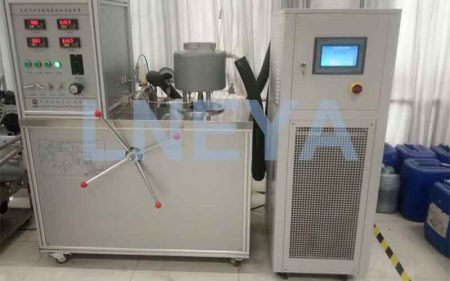
Advantages of laboratory thermostat temperature control system
In order to solve the problems of traditional equipment, laboratory thermostat temperature control system came into being. This equipment combines cooling and heating systems and achieves the goal of integrated cooling and heating temperature control through intelligent control technology. At the same time, the device also has the following advantages:
1. Stable working status
The laboratory thermostat temperature control system uses advanced temperature sensors and thermostat controllers to monitor and adjust the temperature in the reactor in real time. The equipment has high precision and small temperature fluctuations, which can provide a highly stable working environment and ensure the reliability of experimental results.
2. High efficiency and energy saving
The equipment adopts advanced energy-saving technology and can automatically adjust the power according to experimental needs to achieve high-efficiency energy utilization. Compared with traditional equipment, it can greatly reduce energy consumption and reduce laboratory operating costs.
3. Automated operations
The laboratory thermostat temperature control system has automated operation functions. Through the intelligent control system, the temperature curve of the reaction can be preset and the temperature can be adjusted automatically. Researchers only need to set the experimental parameters, and the equipment can automatically operate according to the preset procedures, reducing tedious operating steps and improving experimental efficiency.
4. Multiple reaction modes available
The device provides a variety of reaction modes to choose from, such as constant temperature, heating, cooling, etc. Whether it is a routine experiment or a special experiment that requires temperature changes, it can meet the needs of scientific researchers and expand the applicable scope of the experiment.
5. Diversified interfaces
The laboratory thermostat temperature control system is equipped with a wealth of electronic interfaces and data output interfaces, which can be connected to various detection equipment and data acquisition instruments to facilitate scientific researchers’ comprehensive monitoring of the experimental process and real-time collection and analysis of data.
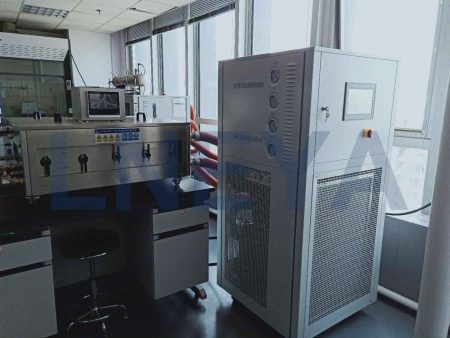
Application of laboratory thermostat temperature control system
Laboratory thermostat temperature control system has been widely used in biology, chemistry, medicine and other fields because of its constant and reliable temperature control and wide range of applications.
In the field of biology, laboratory thermostat temperature control system is mainly used in low-temperature species preservation, cell culture, protein extraction, etc. The thermostat can provide constant temperature and constant humidity, and can control gas concentration at the same time, thereby creating a good environment for biochemical reactions. In the medical field, thermostat is mainly used in drug experiments. Some reaction conditions of drugs need to be carried out at specific temperatures, and the application of drugs in patients also requires experimental and clinical trials in different environments.
In the field of chemistry, thermostat is mainly used in organic chemistry laboratories. With the continuous deepening of organic chemistry research, the selectivity and efficiency of organic chemical reactions are becoming more and more important for the control of experimental conditions. The use of thermostat can effectively control the experimental temperature, thereby improving the efficiency of the reaction. At the same time, the thermostat has a stable temperature adjustment function, which can avoid distortion of experimental results caused by fluctuations in experimental temperature.
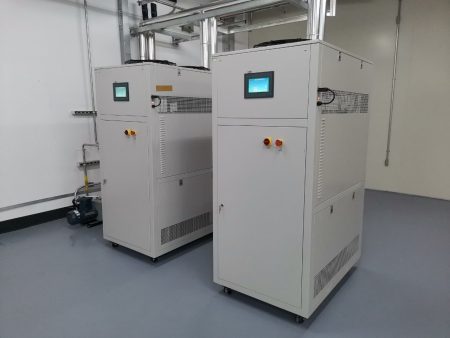
Maintenance of laboratory thermostat temperature control system
The thermostat is a kind of laboratory equipment that is used for a long time, and its maintenance is very important. First of all, daily disinfection should be done. Because there are many bacteria in the working environment of the laboratory thermostat, attention should be paid to its cleaning and disinfection during operation to avoid cross-infection.
Secondly, the controllers, sensors and other components of the equipment need to be carefully preserved. During daily use, in order to avoid damage to the instrument due to accidental smashing, etc., special attention needs to be paid to the sensor in particular. The sensor should be stored in a dry, ventilated, light- and dust-free environment, and should be protected from interference from strong magnetic fields.
Finally, normal faults and repairs are also important steps in laboratory thermostat maintenance. If malfunctions or working abnormalities are found, repairs should be made in time to prevent greater instrument failure.
Conclusion
As an important scientific research instrument, laboratory thermostat provides scientists with necessary environmental conditions, reduces interference factors in experiments, and improves the credibility and repeatability of experiments. It should be noted that the real value of thermostat lies in the correctness of operation and timely maintenance. Therefore, you must pay attention to the usage instructions in actual applications to avoid misuse or damage.
温度制御システムの設計から製造まで一貫して行います。標準モデルから完全なカスタマイズ製品まで 900 .私たちはカスタマーサービスに特化し、お客様一人ひとりのニーズに合った最適な温度制御システムを提供することに専念しています。
私達は標準外カスタマイズされた解決を提供します。単一の冷却のスリラーおよび冷却及び暖房のコンボの単位は両方利用できます。
Eメール info@lneya.com WeChat ID: +8615251628237 WhatsApp: +86 17851209193

冷暖房システム (SUNDIシリーズ)
温度制御範囲:-120°C~+350°C
さまざまな企業で広く利用された冷却および暖房のサーモスタット。
| 温度範囲 | -10 ~ +150℃シリーズ | -25 ~ +200℃シリーズ | -25 ~ +300℃シリーズ | -45 ~ +250°C シリーズ | -45 ~ +300℃シリーズ | -60 ~ +250°C シリーズ | -60 ~ +300℃シリーズ | -70 ~ +250°C シリーズ | -80 ~ +250°C シリーズ | -90 ~ +250°C シリーズ | -100 ~ +100℃シリーズ | ||
| 冷却能力 | 1.5 ~ 15kW | 1~200kW | 1~200kW | 0.45~200kW | 0.9 ~ 25kW | 0.25 ~ 60kW | 0.75 ~ 25kW | 0.4 ~ 15kW | 0.3 ~ 80kW | 0.2 ~ 80kW | 0.45 ~ 80kW | ||
| 注: -150℃の~ +350℃からの温度較差および冷却容量はカスタマイズすることができる | |||||||||||||
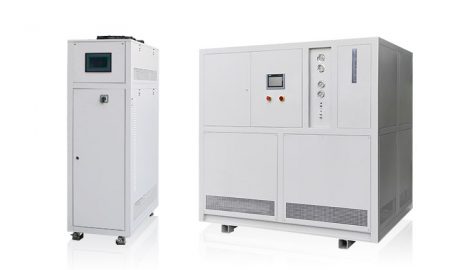
冷暖房システム(WTDシリーズ)
(マイクロチャンネル・チューブリアクター特化型)
温度制御範囲:-70℃~+300
マイクロ流路に特化した設計(液体保持容量が小さく、熱交換容量が大きく、循環システムの圧力損失が高い)
| 温度範囲 | -70°C ~ +300°C | -45°C ~ +250°C | -70°C ~ +200°C | ||||||
| 冷却能力 | 1.1 ~ 7.5kW | 1.5 ~ 5.5kW | 11~50kW | ||||||
| 注: -150℃の~ +350℃からの温度較差および冷却容量はカスタマイズすることができる | |||||||||

冷暖房サーキュレーター
温度制御範囲:-45℃~+250
| 温度範囲 | -25°C ~ +200°Cシリーズ | -45°C ~ +250°C シリーズ | |||||||
| 冷却能力 | 1 ~ 15kW | 0.25 ~ 15kW | |||||||
| 注: -150℃の~ +350℃からの温度較差および冷却容量はカスタマイズすることができる | |||||||||
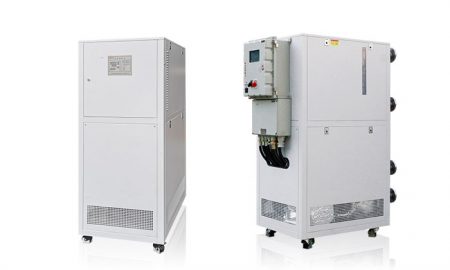
加熱サーキュレーター
温度制御範囲+50℃〜+300
注:UCシリーズは熱媒体の温度を制御することができる。USTシリーズは熱媒の温度を制御できるだけでなく、反応材料の温度も制御できます。
| 温度範囲 | +50°C ~ +170°C(UCシリーズ) | +50°C ~ +300°C(UCシリーズ) | +50°C ~ +300°C(USTシリーズ) | ||||||
| 暖房能力 | 5.5 ~ 15kW | 3.5~130kW | 3.5〜95kW | ||||||
| 注: -150℃の~ +350℃からの温度較差および冷却容量はカスタマイズすることができる | |||||||||
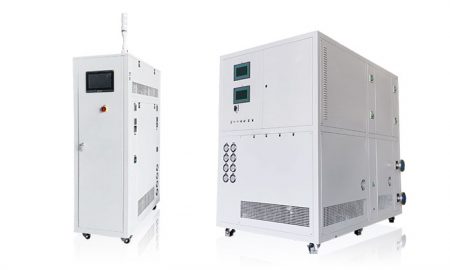
TESシリーズ
温度制御範囲:-85℃~+250
| 温度範囲 | -45°C ~ +250°C シリーズ | -85°C ~ +200°Cシリーズ | -60°C ~ +200°Cシリーズ | ||||||
| 冷却能力 | 0.3 ~ 25kW | 0.25 ~ 25kW | 3〜60kW | ||||||
| 注: -150℃の~ +350℃からの温度較差および冷却容量はカスタマイズすることができる | |||||||||

LTSシリーズ(フッ素系液体)
温度制御範囲:-80°C~+80°C
| 温度範囲 | -20°C ~ +80°Cシリーズ | -45°C ~ +80°Cシリーズ | -60°C ~ +80°C シリーズ | -80°C ~ +80°Cシリーズ | |||||
| フロー制御 | 7 ~ 45 L/分 | 7 ~ 45 L/分 | 7 ~ 45 L/分 | 7 ~ 45 L/分 | |||||
| 注: -150℃の~ +350℃からの温度較差および冷却容量はカスタマイズすることができる | |||||||||
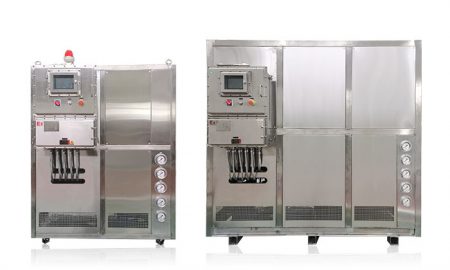
TCU マルチリアクター温度制御システム
温度制御範囲:-120°C~+250°C
| 温度範囲 | -45°C ~ +250°C シリーズ | -120°C ~ +250°Cシリーズ | カスタマイズされた温度制御システム | RT+10°C ~ +135°C | |||||
| 暖房能力 | 25~80kW | 25~80kW | カスタム | 25~300kW | |||||
| 注: -150℃の~ +350℃からの温度較差および冷却容量はカスタマイズすることができる | |||||||||

循環式チラー / 冷凍サーキュレーター
(カスタムデザイン)
チラーは様々な産業や研究所で広く使用することができ、カスタマイズされた設計をサポートしています。
| 温度範囲 | -25°C ~ +30°Cシリーズ | -45°C ~ +30°Cシリーズ | -60°C ~ -20°Cシリーズ | -80°C ~ -20°Cシリーズ | -120°C ~ -70°Cシリーズ | ||||
| 冷却能力 | 0.8 ~ 30kW | 0.75 ~ 12kW | 0.4 ~ 6kW | 0.2 ~ 6kW | 0.3 ~ 5kW | ||||
| 注: -150℃の~ +350℃からの温度較差および冷却容量はカスタマイズすることができる | |||||||||
 ウォーター・チラー/小型チラー
ウォーター・チラー/小型チラー
(カスタムデザイン)
チラーは様々な産業や研究所で広く使用することができ、カスタマイズされた設計をサポートしています。
| 温度範囲 | -18°C ~ +30°C | +5°C ~ +35°Cシリーズ | |||||||
| 冷却能力 | 0.35 ~ 0.9kW | 1.8~50kW | |||||||
| 注: -150℃の~ +350℃からの温度較差および冷却容量はカスタマイズすることができる | |||||||||

低温チラー
(カスタムデザイン)
当社は、-150℃の温度制御範囲を持つ低温冷凍機の生産を専門としており、さまざまな業界の冷凍ニーズを満たすことができます。
| 温度範囲 | -25°C ~ -5°Cシリーズ | -45°C ~ -10°Cシリーズ | -60°C ~ -10°Cシリーズ | -80°C ~ -30°Cシリーズ | -110°C ~ -50°Cシリーズ | -150℃〜-110℃シリーズ | |||
| 冷却能力 | 12~360kW | 6~180kW | 6~180kW | 4〜180kW | 2~120kW | 2.5 ~ 11kW | |||
| 注: -150℃の~ +350℃からの温度較差および冷却容量はカスタマイズすることができる | |||||||||
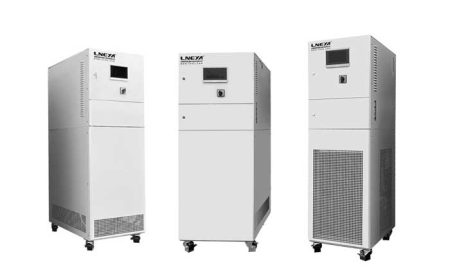
高温チラー
(カスタムデザイン)
チラーは様々な産業や研究所で広く使用することができ、カスタマイズされた設計をサポートしています。
| 温度範囲 | +5°C ~ +40°C | -25°C ~ +40°C | -45°C ~ +40°C | -80°C ~ +80°C | -100°C ~ +80°C | ||||
| 冷却能力 | 6〜40kW | 2~15kW | 1~8kW | 0.6 ~ 3kW | 1.5~3kW | ||||
| 注: -150℃の~ +350℃からの温度較差および冷却容量はカスタマイズすることができる | |||||||||
 LNEYA
LNEYA
 简体中文
简体中文


















































































